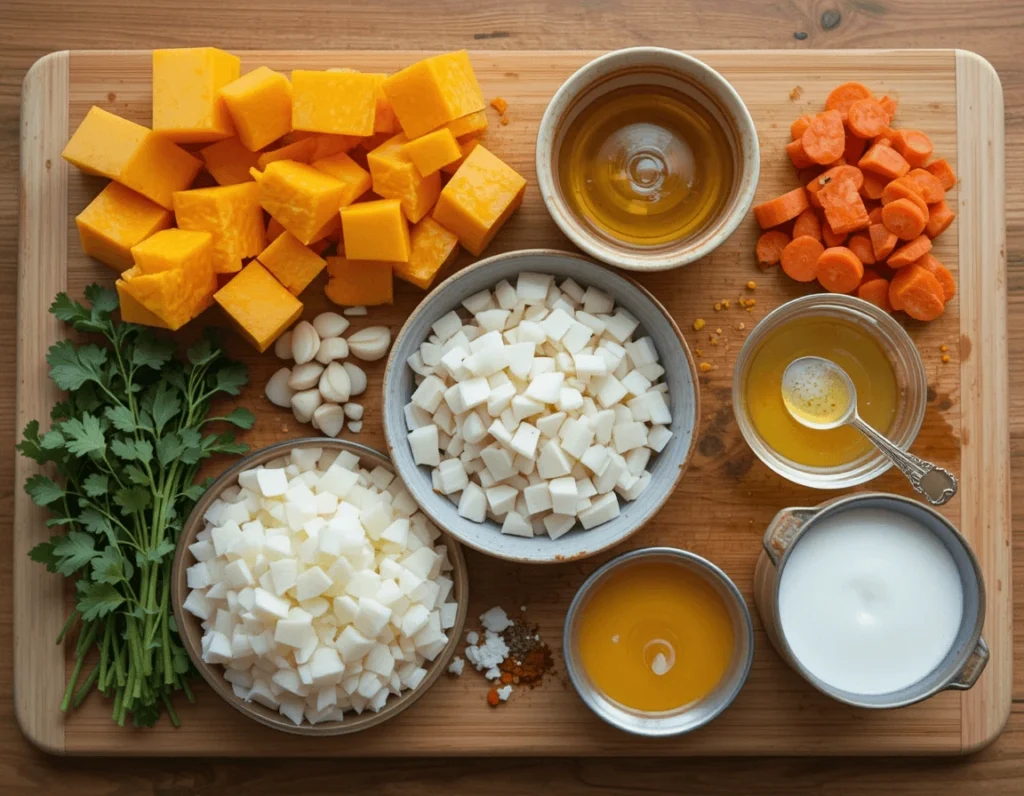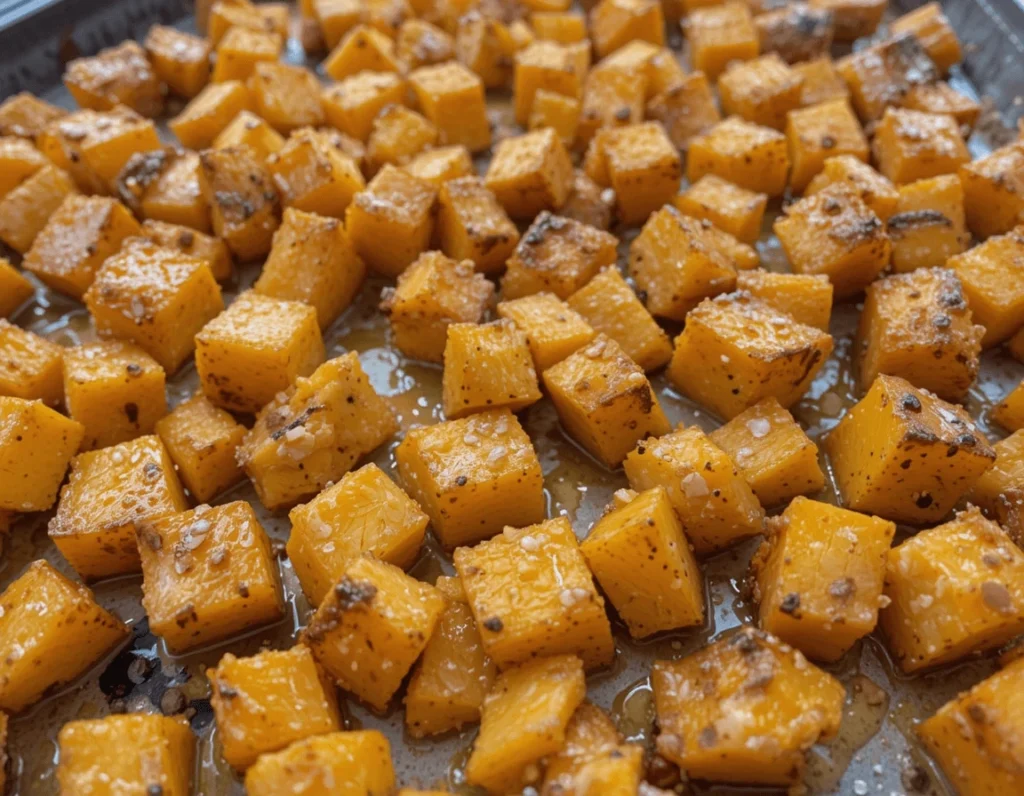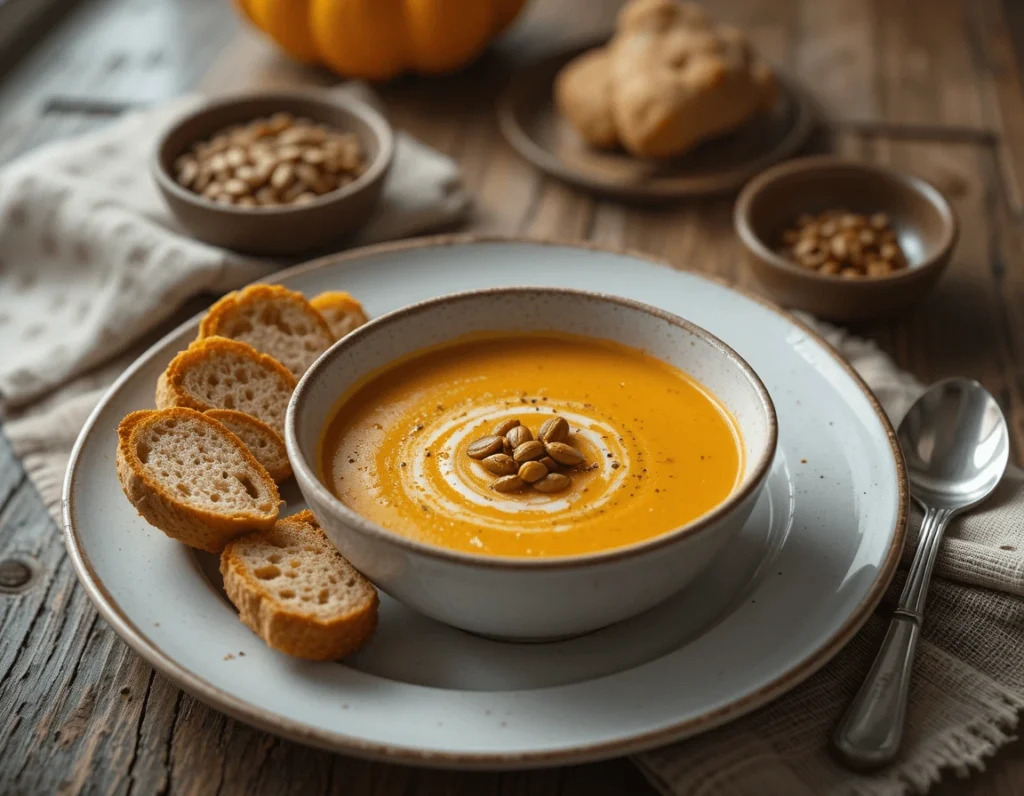Introduction
Butternut squash soup is a warm, comforting dish that’s perfect for chilly evenings. Its naturally sweet flavor, creamy texture, and rich nutrients make it a go-to recipe for fall and winter. Whether you’re looking for a quick weeknight meal or an impressive dish for guests, this soup delivers both simplicity and depth of flavor.
This guide will take you through every step of making butternut squash soup from scratch, including essential ingredients, cooking techniques, and expert tips to customize it to your taste. Whether you prefer it classic, spiced, or with a twist, you’ll find a version that suits your palate.
By the end of this article, you’ll know exactly how to prepare the best butternut squash soup with smooth, velvety texture and perfectly balanced flavors. Let’s get started!
Butternut Squash Soup – A Simple & Delicious Recipe Recap
Short Description
This creamy butternut squash soup is rich, comforting, and packed with flavor. Made with roasted squash, aromatic spices, and a velvety texture, it’s the perfect dish for cozy meals.
Recipe Details
- Prep Time: 15 minutes
- Cook Time: 35 minutes
- Total Time: 50 minutes
- Servings: 4
- Calories: 210 per serving
Nutrition Information (Per Serving)
- Calories: 210
- Total Fat: 9g
- Saturated Fat: 3g
- Carbohydrates: 32g
- Fiber: 6g
- Sugar: 8g
- Protein: 4g
- Sodium: 620mg
Recipe Category
- Course: Soup
- Cuisine: American, Fall Comfort Food
- Diet: Vegetarian, Vegan (with substitutions)
- Method: Roasting, Blending
- Keyword: Butternut squash soup, creamy soup, healthy fall recipe, easy homemade soup
- Skill Level: Beginner
| Nutriment | Quantité par portion (250 ml) | % AJR (Apport Journalier Recommandé) |
|---|---|---|
| Calories | ~180 kcal | – |
| Glucides | 25 g | 8% |
| Fibres | 4 g | 16% |
| Sucres | 7 g | – |
| Protéines | 4 g | 8% |
| Lipides | 7 g | 10% |
| Acides Gras Saturés | 2 g | 10% |
| Sodium | 400 mg | 17% |
| Vitamine A | 10 000 UI | 200% |
| Vitamine C | 25 mg | 28% |
| Vitamine K | 7 mcg | 6% |
| Calcium | 80 mg | 8% |
| Fer | 1.2 mg | 7% |
| Magnésium | 40 mg | 10% |
| Potassium | 500 mg | 14% |
Key Benefits of Butternut Squash Soup
Butternut squash soup isn’t just delicious—it’s packed with health benefits and essential nutrients that make it a great addition to your diet. Here’s why you should make this soup a staple in your kitchen:
1. Rich in Vitamins and Antioxidants
Butternut squash is loaded with vitamin A, which supports eye health and boosts the immune system. It’s also high in vitamin C, an antioxidant that helps reduce inflammation and strengthen immunity.
2. Supports Digestion
With its high fiber content, butternut squash promotes healthy digestion and keeps you full longer. It’s a great option for maintaining gut health and preventing digestive issues.
3. Naturally Low in Calories
Despite its creamy texture, this soup is low in calories and fat, making it a nutritious choice for weight management. It provides a satisfying meal without excess calories.
4. Perfect for Special Diets
This soup is naturally vegetarian and gluten-free, and it can be easily modified to be vegan, dairy-free, or keto-friendly by adjusting the ingredients.
5. Warm and Comforting
With its smooth texture and deep flavor, this soup is the perfect comfort food for fall and winter. It’s a cozy, nourishing dish that can be enjoyed as an appetizer or a main course.
Ingredients for Butternut Squash Soup
Essential Ingredients
To make a creamy and flavorful butternut squash soup, you’ll need the following key ingredients:
- 1 medium butternut squash (about 2–3 lbs), peeled, seeded, and cubed
- 1 tablespoon olive oil (or butter for a richer taste)
- 1 small onion, chopped
- 2 cloves garlic, minced
- 1 medium carrot, diced (adds natural sweetness)
- 4 cups vegetable broth (or chicken broth for extra depth)
- ½ teaspoon salt, or to taste
- ¼ teaspoon black pepper
- ½ teaspoon ground cinnamon (optional, for warmth)
- ¼ teaspoon nutmeg (enhances the squash’s natural sweetness)
- ½ cup coconut milk or heavy cream (for creaminess)
Optional Additions & Variations
- Spicy Kick: Add ¼ teaspoon cayenne pepper or red pepper flakes.
- Extra Creaminess: Use Greek yogurt instead of coconut milk.
- Herb Infusion: Stir in fresh thyme or sage for a richer flavor.
- Protein Boost: Blend in cooked lentils or top with roasted chickpeas.

Instructions: How to Make Butternut Squash Soup
Follow these step-by-step instructions to create a smooth, flavorful, and perfectly balanced butternut squash soup.
1: Roast the Butternut Squash (Optional but recommended for deeper flavor)
- Preheat your oven to 400°F (200°C).
- Toss the cubed butternut squash with 1 tablespoon olive oil, a pinch of salt, and black pepper.
- Spread the squash on a baking sheet and roast for 25–30 minutes, or until tender and slightly caramelized.
- Remove from the oven and set aside.
2: Sauté the Aromatics
- In a large pot, heat 1 tablespoon olive oil over medium heat.
- Add the chopped onion and diced carrot and cook for 3–4 minutes, until softened.
- Stir in the minced garlic, cinnamon, and nutmeg. Sauté for 30 seconds until fragrant.
3: Simmer the Soup
- Add the roasted butternut squash to the pot.
- Pour in 4 cups of vegetable broth and stir well.
- Bring to a gentle boil, then reduce heat and let it simmer for 15 minutes.
4: Blend Until Smooth
- Use an immersion blender to blend the soup directly in the pot until smooth and creamy.
- If using a regular blender, allow the soup to cool slightly before blending in batches.
- Stir in ½ cup coconut milk or heavy cream for extra creaminess.
- Taste and adjust seasoning with more salt, black pepper, or spices as needed.
5: Serve and Enjoy
- Ladle the soup into bowls.
- Garnish with fresh herbs, toasted nuts, or a drizzle of coconut milk.
- Serve warm with crusty bread, crackers, or a side salad.

Pro Tips and Variations
Pro Tips for the Best Butternut Squash Soup
✔ Roast for Maximum Flavor
- Roasting the butternut squash enhances its natural sweetness and adds a deep, caramelized taste. If you’re short on time, you can skip this step, but roasting is highly recommended.
Blend for a Smooth Texture
- An immersion blender makes blending easy and mess-free, but a high-speed blender will give you the silkiest texture. Let the soup cool slightly before transferring to a blender to avoid splattering.
Adjust Consistency
- If the soup is too thick, add more broth or coconut milk until you reach your desired consistency.
- If it’s too thin, let it simmer for a few extra minutes to reduce.
Balance the Flavors
- If the soup tastes too sweet, add a splash of lemon juice or a dash of cayenne pepper to cut through the sweetness.
- If it’s too bland, add a little more salt or spices like smoked paprika or curry powder.

Recipe Variations
Spicy Butternut Squash Soup
- Add ½ teaspoon cayenne pepper or 1 teaspoon red pepper flakes for a spicy kick.
Thai-Inspired Butternut Squash Soup
- Replace coconut milk with full-fat coconut cream and add 1 tablespoon Thai red curry paste for a fragrant, Thai-style soup.
Curried Butternut Squash Soup
- Stir in 1 teaspoon curry powder and ½ teaspoon turmeric for a warming, golden-hued soup.
Butternut Squash & Apple Soup
- Add 1 peeled, chopped apple (such as Honeycrisp or Granny Smith) when sautéing the onions for a subtle sweetness.
Vegan Butternut Squash Soup
- Use coconut milk instead of cream and swap butter for olive oil to keep it completely plant-based.
Serving Suggestions
Pairing the right toppings and sides with your butternut squash soup can take it from a simple dish to a restaurant-quality meal. Here are some delicious ways to serve it:
Best Toppings for Butternut Squash Soup
Crunchy Toppings
- Toasted pumpkin seeds (pepitas) – Add a nutty crunch.
- Croutons – Garlic or herb-seasoned croutons complement the soup’s creaminess.
- Toasted nuts – Chopped walnuts, pecans, or almonds provide texture.
Creamy Enhancements
- Drizzle of coconut milk or heavy cream – Adds extra richness.
- Greek yogurt or sour cream – Gives a tangy contrast to the sweet squash.
Herbs & Spices
- Fresh thyme, sage, or parsley – Brings out earthy flavors.
- Dash of smoked paprika or cayenne – Enhances warmth and spice.
Best Sides to Serve with Butternut Squash Soup
Bread & Crackers
- Crusty sourdough or baguette – Perfect for dipping.
- Cheesy garlic bread – Adds a savory touch.
- Whole grain crackers – A crunchy and healthy pairing.
Protein-Packed Sides
- Grilled cheese sandwich – A classic, comforting combo.
- Roasted chickpeas or lentils – Great for adding plant-based protein.
Salads & Light Sides
- Arugula and walnut salad – The peppery greens balance the soup’s sweetness.
- Apple and pecan salad – Complements the autumn flavors.
Wine Pairings
- Chardonnay or Viognier – Their buttery notes match the soup’s creaminess.
- Sauvignon Blanc – A crisp contrast to the soup’s richness.

Conclusion
Butternut squash soup is a simple yet flavorful dish that’s perfect for any season, especially fall and winter. With its rich, velvety texture and warm, spiced flavors, it’s a comforting meal that can be customized to suit any diet or preference.
By following this guide, you’ve learned:
How to roast butternut squash for maximum flavor
The best spices and ingredients to enhance taste
Different cooking methods and blending techniques
Pro tips, variations, and perfect pairings
Now it’s time to try it yourself! Whether you’re making a classic version, a spicy twist, or a creamy vegan variation, this soup is sure to become a favorite. Serve it with your favorite toppings and enjoy a bowl of homemade goodness!
FAQs
Here are answers to some common questions about making butternut squash soup:
1. Why is my butternut squash soup too thick?
If your soup is too thick, add more vegetable broth, water, or coconut milk until you reach the desired consistency. Stir well and heat gently.
2. How do I make butternut squash soup less sweet?
To balance the natural sweetness, add a splash of lemon juice, a pinch of salt, or a dash of cayenne pepper for a slight kick.
3. Can I use frozen butternut squash for soup?
Yes! Frozen butternut squash works well and saves prep time. Simply cook it directly in the broth without thawing.
4. What can I substitute for butternut squash in soup?
You can use pumpkin, acorn squash, sweet potatoes, or carrots as substitutes for a similar creamy texture and flavor.
5. How do I make butternut squash soup without a blender?
If you don’t have a blender, use a potato masher for a chunky texture or a sieve to strain for a smoother consistency.
“Did you know butternut squash is packed with vitamin A and fiber, making it an excellent addition to a balanced diet? Learn more about its health benefits from Harvard’s Nutrition Source
“Achieving the perfect creamy texture in soups is just as important as keeping your meats juicy. If you’re a fan of expert cooking tips, check out our guide on How To Make Chicken Extra Juicy – Expert Tips For The Best Results!.”

